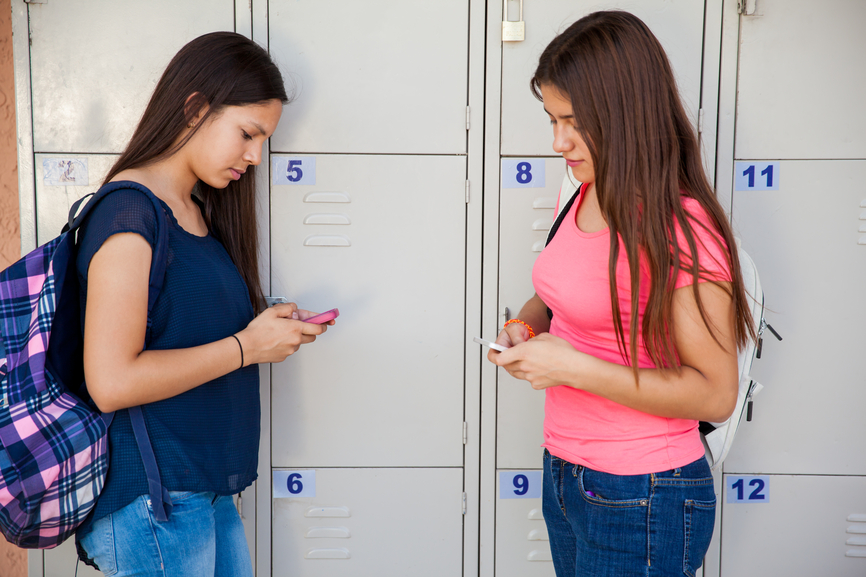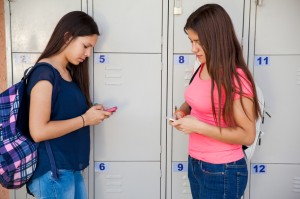The Call on Cell Phone Policies in Schools – Part I

 We’ve all done it or experienced it. You are sharing something deeply personal with a friend when their phone rings. “Oh, sorry. I’ll just be a minute.” they say, leaving you wondering just how deep this relationship really is. A couple is out for a romantic dinner ‘together’ and…both are on their cell phones. You’re at a funeral when…RING/BUZZ/DING goes off and, even worse, the person answers their phone and starts a conversation! And, let us not forget that driving has now become like an obstacle course with trying to avoid swerving cars as they text and drive or with pedestrians who never look up from their phones. The examples are endless.
We’ve all done it or experienced it. You are sharing something deeply personal with a friend when their phone rings. “Oh, sorry. I’ll just be a minute.” they say, leaving you wondering just how deep this relationship really is. A couple is out for a romantic dinner ‘together’ and…both are on their cell phones. You’re at a funeral when…RING/BUZZ/DING goes off and, even worse, the person answers their phone and starts a conversation! And, let us not forget that driving has now become like an obstacle course with trying to avoid swerving cars as they text and drive or with pedestrians who never look up from their phones. The examples are endless.
Cell phones have become many people’s best friends-both figuratively and literally. There is loads of documentation noting that Smartphone addiction is a serious matter. A Google search for iPhone addiction will lead to almost 5 million links, some discussing serious psychological and physiological studies while others are humor related to the problem. But, truth be told, it is no laughing matter.
Lest you not believe that the problem is serious, it is worth reading, “A teen confronts her iPhone addiction”. Just to wet your whistle, the author states about her iPhone, “It’s something that I never go anywhere without, that I talk to when I’m lonely, that I stare at for hours upon end, day after day. It’s there for me when my friends are not. It never argues with me or makes me feel bad about myself. I love it dearly and I can make it tell me that it loves me, too.”
Did you see the movie, “Her” about a man who creates an entire relationship with his voice activated phone? Even his friends think “she’s great” when they double date with “her”-that is, a man/woman couple and a man and his phone couple. Though supposedly taking place in a futuristic time, it appears that the future is here.
From a survey conducted in 2013, 91% of US adults had a cell phone. 97% of people between the ages of 18-24 had a mobile device and 78% of children ages 12-17 also had one. 61% of adults had a Smartphone. We have every reason to believe that now, in 2015, those percentages have substantially increased.
Studies have found that Smartphones are an almost constant source of distraction. A 2013 study found that the average person checks their phone 110x per day!
Research at Southern Maine University found that just the presence of a person’s phone can be enough to divert his attention away from important and/or complex tasks. “The researchers asked volunteers from two university statistics classes to participate in two attention exercises, one simple and one more challenging. In one of the classes, they asked students to keep their phones on their desks while they worked on the cancellation tasks. They were told that one of the tasks would ask about the type of phone they used. In the other class, the phones were kept out of vision.
On the simple tasks, both the phone-visible and the phone-away classes performed comparably. But when it came to the complicated tasks, the group without phones on their desks performed significantly better, getting an average of 26 answers correct, while the phone-visible group got 21 correct.”
These finding are consistent with other studies which indicate that the presence of mobile devices have a negative impact on interpersonal relationships, even when the phone is not being used!
Additionally, what do we find when the phone is being used by our youth? An exponential rise in reported bullying amongst students and the increase in child suicide! These tragic issues have been found to be directly related to cyberspace access. Bullies do not need to be face-to-face with their victims. It is no longer an in-school-only problem. Bullies can now text, Facebook, send pics and wreak havoc on a person’s life 24/7 if they so choose.
Many of us are finding that not only are our students distracted from their studies because of their mobile devices, but also adults are often unfocused as well. We will further explore the cell phone challenge in our next blog. In the meantime, we would like to hear how your school handles the cell phone challenge. What do you think cell phone policies in schools should be?


There are more than a few Youtube videos of teachers enforcing their “absolutely no cell phone” policies in classrooms. e.g. https://www.youtube.com/watch?v=5gsDKtZb8Yc https://www.youtube.com/watch?v=8dq_a4Fi60M, etc, etc…. The bullying portion of your essay has little relevance to the question of whether cell phone use should be allowed in the classroom. Bullying is a problem, but it’d be a problem even if cell phones were banned entirely from the classroom. Arguments you didn’t raise: emergency contacts. Equal accessibility to helpful information. Seems that a well publicized emergency phone number for reaching the school’s office should take care of concerns about reaching students in the event of an emergency. And not everybody can afford a smart phone with a data plan so they can consult Internet resources during class. I believe the right policy is to absolutely forbid cell phones in the classroom And that rule goes for teachers too. Want classroom access to Internet resources? Then provide PC’s or tablets for all to use in the classroom. Separate problem: How to assure “inappropriate” sites aren’t accessed by the students using the provided equipment. I don’t have a good answer for that.
Thank you for your insightful comments. Stay tuned for Part 2 on this topic which covers some of your thoughts. Clearly, the cell phone issue will haunt us for a long time and is not quickly resolvable. Having a clear school policy, whatever it may be, might be the only answer for now.
Cell phones are definite distractions to students. Students use them more for games. social updates, and cheating on test. Cell phones are to be for emergencies only. Most students treat it as a toy. There is no place for cell phones in the school. If parents want to contact their children, all they need to do is call the school with the child’s name and class number. Students outside the school become targets for those who rob students. There are more negatives than positives for students having cell phones.
Thank you for sharing. It is so interesting the wide variety of thoughts, feelings and actions on this subject. Time will tell what the results will be.